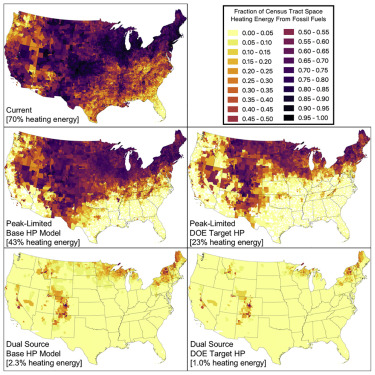Joule ( IF 38.6 ) Pub Date : 2019-12-20 , DOI: 10.1016/j.joule.2019.11.011 Michael Waite , Vijay Modi

|
We investigate implications of building space heating decarbonization pathways across the climate-diverse United States. We compute that an “all-electric” approach could require a 70% increase in nationwide electricity system capacity. New peak loads would be highly heterogeneous (e.g., 4-fold increase in some states) with very low load factors (fewer than 100 full load hours annually). Without increasing peak loads, currently available electric heat pumps can reduce fossil fuels to 43% of total heating energy supply (currently 70%). Future advances in heat pump technology could reduce this further to 23%; however, several challenging regions would remain. We show that installing heat pumps and retaining some fossil fuel equipment for use in only the coldest weather could reduce fossil fuels to 1%–3% of heating energy while progressively reducing fossil fuel heating capacity and avoiding electricity capacity upgrades. Therefore, strategic use of legacy infrastructure could facilitate a more flexible transition to low-carbon heating.
中文翻译:

空间加热脱碳途径的电负荷含义
我们调查了遍及美国气候变化的空间供暖脱碳途径的意义。我们计算出,“全电”方法可能需要将全国电力系统容量增加70%。新的峰值负载将高度异构(例如,在某些状态下增加4倍),而负载因子却非常低(每年少于100个完整负载小时)。在不增加峰值负荷的情况下,当前可用的电热泵可以将化石燃料减少到总供暖能源供应的43%(目前为70%)。热泵技术的未来发展可能会将这一比例进一步降低至23%。但是,仍将存在几个具有挑战性的地区。我们表明,安装热泵并保留一些仅在最冷的天气中使用的化石燃料设备可以将化石燃料减少到占热能的1%–3%,同时逐步减少化石燃料的供暖能力并避免电能力的升级。因此,对旧有基础设施的战略性使用可以促进向低碳供暖的更灵活过渡。











































 京公网安备 11010802027423号
京公网安备 11010802027423号